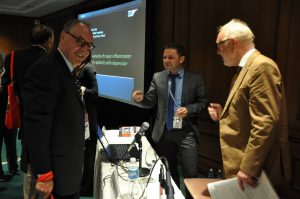Aktualności naukowe
Najnowsze:
Nowa pozycja książkowa:
Tytuł: Metodyka pracy biegłego psychiatry, psychologa oraz seksuologa w sprawach karnych. Eichstaedt Krzysztof, Gałecki Piotr, Depko Andrzej. LexisNexis, 2012. Warszawa.
zobacz pozycję
Nagroda Ministra Zdrowia
Piotr Gałecki, jako wnioskodawca zespołu naukowego, odebrał Zespołową Nagrodę Naukową Ministra Zdrowia za 2010 rok, za cykl 7 publikacji (w każdej był pierwszym autorem) dotyczących oceny genów i mechanizmów procesów zapalnych i związanych ze stresem oksydacyjnym w zaburzeniach depresyjnych.
zobacz
Zaproszenie przez Prof. Torbena Moosa na wykład na sympozjum organizowanym przez Danish Society for Neuroscience, 1-3.05.2011, Sandbjerg Manor, Sønderborg, Denmark. Program (odnośnik do programu)
Sesja na 15th World Congress of Psychiatry, 18-22.09.2011, Buenos Aires, Argentina.
Title: DEPRESSION AS AN INFLAMMATORY DISEASE
Chairpersons: M. Maes (Thailand), M. Abou-Saleh (UK)
- The role of inflammatory, oxidative and nitrosative stress pathways in depression M. Maes (Thailand)
- Inflammation and major depression: the role of TH1/TH2 shift in neuroimmune interactions and its relevance in cancer prognosis L.R. Frick (Argentina)
- Genetic variants of major inflammatory enzymes in patients with depression P. Galecki (Poland)
- Evidence of mitochondrial dysfunction in bipolar disorder: findings from postmortem brain and peripheral cells A. Andreazza (Canada)
Sesja na 10th World Congress of Biological Psychiatry, 29.05-2.06.2011, Prague, Czech Republic
Title: Inflammatory, oxidative and nitrosative pathways in major depression: New drug targets for antidepressive treatments and causes for the neurodegenerative processes in that illness
Chair: Michael Maes , Belgium; Co-Chair: Brian Leonard , Ireland
- Selective serotonin reuptake inhibitors and nonsteroidal anti-infl ammatory drugs attenuate inflammatory and oxidative pathways and have a signifi cant therapeutic efficacy in the treatment of depression Piotr Galecki (Poland)
- Increased oxidative stress causes neuronal apoptosis in the hippocampus and neocortex Brian Leonard (Ireland)
- The role of zinc and zinc defi ciency in depression and neurodegeneration Gabriel Nowak (Poland)
Sesja na 24th ECNP Congress, 3 – 7 September 2011Paris, France
Title: Oxidative and nitrosative stress in major depression: new pathways and novel drug targets
Chair: Martin Hatzinger, Switzerland
Chair: Julien Mendlewicz, Belgium
- Oxidative and nitrosative stress pathways in depression Michaël H.J. Maes (Thailand)
- Functional polymorphisms in oxidative and nitrosative stress genes Piotr Galecki (Poland)
- Mitochondria, free radicals and inflammation in mood disorders and functional syndromes Ann Gardner (Sweden)
- Oxidative stress in depression – is there a lesson to be learnt for the therapy of depression from post-mortem research Tanja Michel (Germany)
- Antidepressive properties of antioxidants Giovanni Scapagnini (Italy)
Prace przyjęte do druku:
The role of the right hemisphere in the etiology of the depressive disorders
Talarowska M., Orzechowska A., Zboralski K., Gałecki P. Psychiatria Polska.
Many differences between the hemispheres have been observed, from the gross anatomical level to differences in dendritic structure or neurotransmitter distribution. Analytic reasoning and language functions such as grammar and vocabulary often are lateralized to the left hemisphere of the brain. The right cerebral hemisphere plays a special role in tasks involving the direction of spatial attention, recognition of faces, perception, possibly generation of affect and affective prosody. Depression is associated with many different cognitive impairments e.g. in the domains of working memory and executive functions as well as interpersonal and social cognition problems. Little is known about the relationship between cognitive and affective deficits in depression. Researchers have hypothesized that the laterality of brain damage may facilitate the expression of emotional or affective disturbances. The aim of the study is to describe the role of right hemisphere in the etiology of depressive disorders.
Results of the Benton Visual Retention Test and the Bender Visual-Motor Gestalt Test among patients suffer from depressive disorders and organic depressive disorders
Talarowska M., Florkowski A., Zboralski K., Gałecki P. Psychiatria Polska.
Aim: The comorbidity of depression and dementia has been extensively studied. Four main hypotheses have been suggested to explain the relationship between depression and dementia: 1. depression may be a psychological reaction to perceived cognitive decline, 2. depression may be an early symptom of dementia, 3. depression may be an etiologic risk factor for the onset of dementia, and 4. dementia and depression share common risk factors. The objective of this study was to examine the differences between depressive disorders and organic depressive disorders by using two neuropsychological tests. Methods: A sample of 61 persons aged 23-62 years participated in the study. Patients who took part in the investigation were divided into two groups: depressive disorders (DD, n=30), organic depressive disorders (ODD, n=31). Cognitive functions were evaluated by the Benton Visual Retention Test (BVRT) and Bender Visual-Motor Gestalt Test (BVMGT). Results: Relevant statistical differences among examined group were observed: in BVRT correct answers (p=0,006), errors (p<0,001); in BVMGT: (p<0,001). DD patients achieved higher results in psychological test than ODD patients. DD group (average) in BVRT: correct answers (-1,33), errors (2,31); BVMGT (average): (50,37). ODD group (average) in BVRT: correct answers (-2,71), errors (5,81); BVMGT (average): (72,01). Conclusions: 1. Patients with organic depressive disorders achieved significantly lower results than patients with depressive disorders in BVRT and BVMGT.
Stroop Test in the examination of psychiatric patients and patients with diabetes
Talarowska M., Zboralski K., Florkowski A., Wysokiński A., Orzechowska A., Gałecki P.
Clinical and Experimental Medical Letters. Background. Short-term memory, associated with short-time storage of the information necessary to perform a current task and of the information concerning the criteria for an action performed at a given moment, is referred to as the working memory. The Stroop Test is used for verbal working memory evaluation. Material and Methods. The aim of the study is an evaluation of the efficacy levels of the working memory and executive functions in healthy subjects (n=60), patients with paranoid schizophrenia (n=44), and patients with diabetes (n=62) – type 1 diabetes (n=31) and type 2 diabetes (n=31). The Stroop Test was used in the study. Results. The best results, were obtained by healthy subjects (RCNbtime: M=21.07, SD=0.42; RCNberrors: M=0.02, SD=0.02; NCWdtime: M=51.83, SD=1.47; NCWderrors: M=1.23, SD=0.23) and patients with diagnosed type 1 diabetes mellitus (RCNbtime: M=21.58, SD=0.70; RCNberrors: M=0.16, SD=0.16; NCWdtime: M=52.68, SD=2.08; NCWderrors: M=2.23, SD=0.54). The lowest scores were noted for the subjects with schizophrenia (RCNbtime: M=29.80, SD=1.78; RCNberrors: M=0.12, SD=0.11; NCWdtime: M=90.39, SD=6.94; NCWderrors: M=3.30, SD=1.12) and type 2 diabetes mellitus (RCNbtime: M=27.10, SD=1.92; RCNberrors: M=0.32, SD=0.12; NCWdtime: M=65.23, SD=2.87; NCWderrors: M=4.58, SD=0.74). Sten norms of the Stroop Test were developed for general population. Discussion. 1.Healthy subjects and type 1 diabetics achieved significantly better results in Stroop Test performance than the studied schizophrenics and type 2 diabetics. 2.The standards, defined by the authors, provide normalisation of results of patient performance on the Stroop Test and may be used in neuropsychological examination of subjects in general population.
Stroop Test among patients suffering from depressive disorders and schizophrenia
Talarowska M., Florkowski A., Orzechowska A., Mossakowska-Wójcik J., Gałecki P.
Current Problems of Psychiatry. Aim: The aim of the study is an evaluation of verbal-auditory working memory and executive functions efficacy in patients with depressive disorders and patients with schizophrenia. Cognitive functions were evaluated by the Stroop Color Word Interference Test (Stroop test). Method: A sample of 104 persons aged 18-55 years (M = 43,66, SD = 13,27) participated in the study. Study participants were divided into two groups: patients with schizophrenia (n = 44) and patients with depressive disorders (n = 60). The mean results in Positive and Negative Syndrome Scale (PANSS) for schizophrenia patients: M = 68,67, SD = 28,83. The mean results in Hamilton Depression Rating Scale (HDRS) for patients suffering from depressive disorders: M = 21,08, SD = 5,93. Results: Any relevant statistical differences among examined group were not observed. The worse results in the first part of Stroop Test (RCNb) achieved depressive patients: time (s) – M = 34,28, SD = 15,94 (patients with schizophrenia: M = 29,79, SD = 11,81). In the second part of Stroop Test (NCWd) the worse results obtained schizophrenic patients: time (s) – M = 90,39, SD = 46,03, number of errors – M = 4,43, SD = 7,44 (depressive patients: time (s) M = 79,77, SD = 49,41, number of errors – M=3,29, SD=5,58. Conclusions: 1. Depressive patients do not differ from schizophrenic patients in Stroop test performance.
Selected diabetes control indicators and working memory efficacy
Macander M., Talarowska M., Gałecki P., Moczulski D., Lewiński A.
Neuroendocrinology Letters. BACKGROUND: The goal of the study was an evaluation of differences in working memory effectiveness between patients with type 1 and type 2DM. It was also attempted to ascertain whether the level of diabetes control is associated with working memory effectiveness. METHODS: 62 subjects were enrolled into the study. All patients were divided into two groups: patients with type 1DM (n=31) and with type 2DM (n=31). The Trail Making Test (TMT) and the Stroop Test were used for evaluation of working memory effectiveness. Diabetes control indicators included: glycated haemoglobin (HbA1C) level, total cholesterol concentration, HDL and LDL cholesterol concentration and body mass index (BMI). RESULTS: The patients with type 1DM obtained a significantly lower time in the execution of TMT, part B(p=0.01) and of RCNb(p=0.01) and NCWd(p=0.01) versions of the Stroop Test, while making significantly less errors in NCWd version(p=0.01). Significant correlations were demonstrated between BMI values and the rate of execution of TMT, part B(p=0.03), as well as the rate of execution of RCNb(p=0.04) and NCWd(p=0.01) versions of the Stroop Test. Total cholesterol level was significantly correlated with the rate of execution of TMT, part A(p=0.04) and B(p=0.01). No significant correlations were found between cholesterol fraction levels in blood of the studied patients and the results of performed tests, with one exception, regarding the relationship between LDL cholesterol fraction and the rate of the Stroop Test execution in RCNb version(p=0.04). CONCLUSIONS: 1). Higher working memory efficacy was demonstrated among the patients with type 1DM vs. those with type 2DM. 2). The level of diabetes control is an influential factor for working memory effectiveness in diabetic patients.
Premature ejaculation – definition, classification and therapy – part I and part II.
Gałecki P., Depko A., Bobińska K., Mossakowska J., Ciosek M., Mazur J., Talarowska M.
Current probems of Psychiatry. Premature ejaculation (PE) and erectile dysfunction (ED, impotence) are the two main complaints in male sexual medicine. It can affect men at all ages and has a serious impact on the quality of life for men and their partners. Although PE is a very common male sexual dysfunction, it is poorly understood. Patients are often unwilling to discuss their symptoms and many physicians do not know about effective treatments. Therapy should involve the man and his partner (mainly psychotherapy and sexual education). The primary aims of therapy are for the man to extend the intravaginal ejculation latency time (IELT), to regain a sense of control over his ejaculation time and for him and his partner to feel satisfaction with sexual intercourse. The most effective therapies for PE are: tricyclic antidepressants, certain selective serotonin reuptake inhibitors (SSRI, mainly dapoxetine), serotonin antagonist and reuptake inhibitor (SARI) and phosphodiesterase type 5 inhibitors (PDE-5), given on a daily basis or “on demand” before sexual activity. Topical anaesthetics have also been shown to be effective. The aim of the study is to describe the prevalence, the diagnosis and the classification of the PE. In the second part the main issues which are connected with biological therapy (pharmacotherapy) of the PE were described.
Premature ejaculation – definition, classification and therapy – part I and part II.
Gałecki P., Depko A., Bobińska K., Mossakowska J., Ciosek M., Mazur J., Talarowska M.
Current probems of Psychiatry. Premature ejaculation (PE) and erectile dysfunction (ED, impotence) are the two main complaints in male sexual medicine. It can affect men at all ages and has a serious impact on the quality of life for men and their partners. Although PE is a very common male sexual dysfunction, it is poorly understood. Patients are often unwilling to discuss their symptoms and many physicians do not know about effective treatments. Therapy should involve the man and his partner (mainly psychotherapy and sexual education). The primary aims of therapy are for the man to extend the intravaginal ejculation latency time (IELT), to regain a sense of control over his ejaculation time and for him and his partner to feel satisfaction with sexual intercourse. The most effective therapies for PE are: tricyclic antidepressants, certain selective serotonin reuptake inhibitors (SSRI, mainly dapoxetine), serotonin antagonist and reuptake inhibitor (SARI) and phosphodiesterase type 5 inhibitors (PDE-5), given on a daily basis or “on demand” before sexual activity. Topical anaesthetics have also been shown to be effective. The aim of the study is to describe the prevalence, the diagnosis and the classification of the PE. In the second part the main issues which are connected with biological therapy (pharmacotherapy) of the PE were described.
2011
Association between inducible and neuronal nitric oxide synthase polymorphisms and recurrent depressive disorder.
Gałecki P, Maes M, Florkowski A, Lewiński A, Gałecka E, Bieńkiewicz M, Szemraj J.
BACKGROUND: Major depression is characterised by increased nitric oxide (NO) levels. Inhibition of the NO synthesizing enzymes, neuronal nitric oxide synthase (nNOS) and inducible nitric oxide synthase (iNOS), results in antidepressant-like effects, whereas the expression of iNOS and nNOS is increased in depression. Recent studies have indicated that NOS participates in the mechanisms of antidepressants. The aim of this study was to examine whether a single nucleotide polymorphism (SNP) present in the genes encoding iNOS and nNOS can contribute to the risk of developing recurrent depressive disorder (rDD). METHODS: The study was carried out in a group of 181 depressive patients and 149 control subjects of Polish origin. SNPs were assessed using polymerase chain reaction (PCR) and restriction fragment length polymorphism (RFLP) analyses. RESULTS: The genotype distributions of the polymorphisms in exon 22 of the NOS2A gene and in exon 29 of the nNOS gene were significantly different between rDD patients and controls. The results showed that the G/A SNP of the gene encoding iNOS was associated with an increased susceptibility to rDD, whereas A/A homozygous carriers had a decreased risk of developing rDD. There was also a significant association between the C/T SNP of the gene encoding nNOS; the presence of the CC homozygous genotype decreased the risk of rDD, whereas the T allele and T/T homozygous genotype increased the vulnerability to rDD. CONCLUSIONS: Our results suggest that polymorphisms in the iNOS and nNOS genes confer an increased susceptibility or resistance to rDD. Future research should examine genetic variants and their associations to the expression of NOSs and NO level in depressive patients. Spatio-visual working memory effectiveness and depression levels after pharmacological therapy with SSRI – preliminary study. Talarowska M., Florkowski A., Berent D., Gałecki P. European Psychiatric Association 19th European Congress of Psychiatry, Vienna, Austria, 12-15 March 2011.
The influenza infection and cognitive functions.
Talarowska M., Florkowski A., Macander M., Gałecki P.
Neuropsychiatria i Neuropsychologia 2010; 5, 3-4: 149–154. Influenza is a seasonal viral disease. Every year 5-25% of the world’s population suffers from influenza and up to 1 mln people die. In Poland several thousand to several million cases and suspected cases of influenza are registered every epidemic season. According to WHO, respiratory viruses are pathogens that infect people most frequently. Epidemiological studies have indicated a link between influenza type A infection (subtype H3N2 and H1N1), type B infection and cognitive functions impairment (mainly declarative memory, attention, visual-movement coordination), neurodegenerative diseases, neurological symptoms and certain psychiatric diseases (e.g. schizophrenia). Both acute and chronic systemic inflammation are characterized by the systemic production of the proinflammatory cytokines in the brain: tumor necrosis factor-α (TNF-α), interleukin-1 (IL-1), IL-2 and IL-6. Higher peripheral levels of inflammation are associated with activation of central inflammatory mechanisms that result in hippocampal neurodegeneration. The aim of the study is to describe present research about impact of influenza infection on cognitive functions. The authors are aware of the lack of empirical data confirming connections between inflammation and cognitive functions but they would like to try present this approach.
Editorial: (Neuro)inflammation and neuroprogression as new pathways and drug targets in depression: From antioxidants to kinase inhibitors.
Talarowska M., Florkowski A., Macander M., Gałecki P. J Affect Disord. 2011;129(1-3):175-82.
Prog Neuropsychopharmacol Biol Psychiatry. 2011 Mar 2. [Epub ahead of print].
Single nucleotide polymorphisms and mRNA expression for melatonin MT(2) receptor in depression.
Gałecka E, Szemraj J, Florkowski A, Gałecki P, Bieńkiewicz M, Karbownik-Lewińska M, Lewiński A. Psychiatry Res. 2011 Feb 24. [Epub ahead of print].
Prog Neuropsychopharmacol Biol Psychiatry. 2011 Mar 2. [Epub ahead of print].
Trudności diagnostyczne w Zespole Fahra.
Lechańska J., Helman B., Florkowski A., Zboralski K., Kuśmierek M., Gałecki P., Talarowska M.
XVI Konferencja Szkoleniowo-Naukowa z cyklu: „Farmakoterapia, psychoterapia i rehabilitacja zaburzeń afektywnych” na temat: „Choroby afektywne – wyzwania i nadzieje” Zakopane: 18 – 20 luty 2011 r.
Poczucie własnej skuteczności a poziom odczuwanego stresu wśród strażaków zawodowych.
Kryszkowski W., Florkowski A., Orzechowska A., Gałecki P., Talarowska M.
XVI Konferencja Szkoleniowo-Naukowa z cyklu: „Farmakoterapia, psychoterapia i rehabilitacja zaburzeń afektywnych” na temat: „Choroby afektywne – wyzwania i nadzieje” Zakopane: 18 – 20 luty 2011 r.
Psychiatric and psychological complications in obstructive sleep apnea syndrome.
Gałecki P, Florkowski A, Zboralski K, Pietras T, Szemraj J, Talarowska M.
Pneumonol Alergol Pol. 2011;79(1):26-31. Review. Polish.
2010
Auditory-verbal declarative and operating memory among patients suffering from depressive disorders – preliminary study.
Talarowska M, Florkowski A, Zboralski K, Berent D, Wierzbiński P, Gałecki P. Adv Med Sci. 2010;55(2):317-27.
PURPOSE: Dysfunctions of auditory-verbal declarative and working memory are observed in patients with depressive disorders (DD). The authors wanted to see, whether antidepressive therapy improved the efficiency of cognitive processes among patients suffering from DD and determine possible associations between auditory-verbal declarative and working memory performance, evaluated before treatment vs. remission degree after treatment. MATERIAL AND METHODS: The study was carried out in 87 subjects, patients with depressive disorders (n=30, DD) and healthy subjects (n=57, CG, control group). The AVLT (Auditory Verbal Learning Test) and the Stroop Test were used. RESULTS: CG obtained higher results vs. DD-I (the evaluation started on the therapy onset) in the Stroop Test-RCNb (Reading Colour Names in Black)/time, NCWd (Naming Colour of Word – Different)/time, NCWd/errors, AVLT: the number of words after 30 minutes. CG demonstrated higher results than DD-II (following eight weeks of pharmacological treatment) in RCNb/time, NCWd/time, AVLT: the number of words in the first trial, the number of words after 30 minutes. Compared to DD-I, DD-II achieved better results in NCWd/errors. No statistically significant differences were observed in both tests between the patients with remission and without remission. Statistical analysis revealed the lack of significant dependences among HDRS after treatment and cognitive functions before treatment.
CONCLUSIONS: Depressive disorders are associated with deteriorated efficiency of auditory-verbal declarative and working memory. No improvement was observed in the efficiency of auditory-verbal declarative or working memory after 8-week therapy. The performance level of cognitive processes before pharmacotherapy has no effect on the intensity of depression symptoms after therapy.
Współczesne metody postępowania terapeutycznego w pedofilii.
Berent D., Depko A., Talarowska M., Florkowski A., Gałecki P.
Farmakoterapia w Psychiatrii i Neurologii 2010, 12(3-4):149164.
Trudności diagnostyczne w Zespołu Fahra – opis przypadku.
Kuśmierek M., Lechańska J., Helman B., Talarowska M., Florkowski A., Gałecki P.
CURRENT PROBLEMS OF PSYCHIATRY 2010; 11(4): 283-287.
Cerebrolizyna w organicznym zespole amnestycznym – opis przypadku.
Berent D., Talarowska M., Orzechowska A., Florkowski A., Gałecki P.
Psychiatria i Psychoterapia 2010, 6, 3-4: 11-18.
Znaczenie rodziny dla przebiegu astmy oskrzelowej.
Orzechowska A, Gałecki P, Talarowska M, Florkowski A, Pietras T, Górski P.
Post Dermatol Alergol 2010; XXVII, 6: 477–483.
Skala MoCA w diagnostyce zespołu amnestycznego – opis przypadku.
Talarowska M., Berent D., Orzechowska A., Zboralski K., Gałecki P.
Psychiatria Polska, 2010, XLIV,6:905-913. Aim. Among main symptoms of the amnestic syndrome we can distinguish: short-term and long-term memory deterioration, deficiency of the effectiveness of learning, the anterograde amnesia and the retrograde amnesia, lack of the orientation in the place and in the time and confabulations. The aim of the study is to introduce the unknown tool of cognitive assessment named Montreal Assessment Cognitive (MoCA). The authors want to indicate the diagnostic accuracy of the scale in the examination of the amnestic patient. Method. In the neuropsychological examination of the amnestic patient, the Montreal Cognitive Assessment scale was used. Results. The patient correctly performed the tasks which estimated effectiveness of the visual-motor coordination, language abilities (naming, repeating of the sentences) and effectiveness of the short-term memory. Difficulties in the remaining tasks indicate at deficiency of the effectiveness of the learning ability, long-term memory (recognition), abstractive thinking and the orientation in the place and time. Deterioration of the working memory and executive functions is also noticeable. Conclusions. Montreal Cognitive Assessment scale is a useful tool for the evaluation of the cognitive functions among amnestic patients.
Czy prawa półkula mózgu odgrywa rolę w etiologii zaburzeń depresyjnych?
Talarowska M., Florkowski A., Wierzbiński P., Gałecki P.
IV Międzynarodowa Konferencja Naukowo-Szkoleniowa Optymalizacja leczenia w psychiatrii, Wisła, 9-11 grudnia 2010r.
Zaburzenia funkcji poznawczych po usunięciu oponiaka rynienki węchowej – opis przypadku.
Talarowska M., Zboralski K., Berent D., Gałecki P.
Neuropsychiatria i Neuropsychologia 2010; 5, 2:95-101.
Anxiety, depression and polymorphism of the gene encoding superoxide dismutase in patients with chronic obstructive pulmonary disease.
Pietras T, Witusik A, Panek M, Gałecki P, Szemraj J, Górski P.
Pol Merkur Lekarski. 2010;29(171):165-8.
An inducible nitric oxide synthase polymorphism is associated with the risk of recurrent depressive disorder.
Gałecki P, Maes M, Florkowski A, Lewiński A, Gałecka E, Bieńkiewicz M, Szemraj J.
Neurosci Lett. 2010;486(3):184-7. Epub 2010 Sep 30. Evidence indicates that depressive disorder is a heterogenic disease, and oxidative stress, inflammation and impairment of neurogenesis play a role in its aetiology. Moreover, there are data suggesting that genetic factors affect the development of depression. Nitric oxide (NO) is a biological molecule with both a beneficial and a detrimental role in brain. One of the three enzymes generating NO is inducible nitric oxide synthase (iNOS). Recent studies have shown that depressed patients are characterised by excessive NO production. In addition, iNOS inhibitors are effective in depression treatment. This study investigated the importance of a functional single nucleotide polymorphism (SNP), -1026C/A, located in the promoter region of the human NOS2A gene, for the risk of recurrent depressive disorder (RDD) vulnerability. The study was carried out in a group of 181 patients with RDD and 149 ethnically matched controls. Genotyping was performed by direct sequencing of the polymerase chain reaction (PCR) products. The genotype distribution of the -1026C/A polymorphism between depressed patients and healthy controls was significantly different. Individuals who were homozygous for the CC genotype exhibited an increased risk of developing RDD. In conclusion we cautiously conclude that polymorphism in the NOS2A gene promoter may play a role in the background of RDD.
The risk of death following the consumption of ethanol based on forensic research material.
Talarowska M, Ostrycharczyk K, Florkowski A, Jurczyk AP, Gaļecki P.
Pol Merkur Lekarski. 2010;29(170):100-2.
The shaken baby syndrome as a kind of domestic abuse.
Talarowska M, Florkowski A, Mossakowska J, Gałecki P.
Pol Merkur Lekarski. 2010;29(169):70-3. Review.
Effectiveness of trazodone in the treatment of sexual dysfunctions.
Gałecki P, Florkowski A.
Pol Merkur Lekarski. 2010;29(169):66-9. Review.
Münchausen syndrome by proxy.
Berent D, Florkowski A, Gałecki P.
Psychiatr Pol. 2010;44(2):245-54. Review.
Restless legs syndrome.
Kryszkowski W, Florkowski A, Bobińska K, Gałecki P.
Psychiatr Pol. 2010;44(2):235-43. Review.
Neuropsychological examination among patients suffering from transient global amnesia.
Talarowska M, Florkowski A, Zboralski K, Gałecki P.
Psychiatr Pol. 2010;44(3):361-70. Review.
Differences in the course of depressive disorders among women and men measured by MMPI-2.
Talarowska M, Florkowski A, Zboralski K, Gałecki P.
Psychiatr Pol. 2010;44(3):319-28.
AIM: The aim of the study is to assess the differences between clinical scales of MMPI-2 among women and men suffering from depressive disorders. METHOD: 36 patients were examined (aged 23-62 years, average age = 51.27, SD = 8.84): 19 women (52.77%, aged 23-59, average age = 51.16, SD = 4.74) and 17 men (47.23%, aged: 23-61, average age = 51.41, SD = 12.07). All patients were hospitalised in the Clinic of Adult Psychiatry Medical University of Łódź. The Minnesota Multiphasic Personality Inventory (MMPI-2, adapted by T. Kucharski) and Hamilton Depression Rating Scale (HDRS, consisting of 21-items) were used. MMPI-2 is used in psychological diagnostic and HDRS is used to assess the intensity of depressive disorders.
RESULTS: Relevant statistical differences between women and men in the several clinical scales of MMPI-2 were observed. There were no relevant statistical differences between the examined groups in the HDRS. CONCLUSIONS: (1). The characteristic symptoms of depressive disorders for women are: the excessive concentration on physical health, numerous complaints about physical disabilities, lack of energy, insomnia, diminishing of attention concentration and low self-esteem, diffidence and pessimism (2). Examined men achieved statistically lower results than women in the following scales: hypochondria, hysteria and D1, D3, D4 subscales of the depression scale. (3). MMPI-2 is one of the psychological methods which allow for a specific diagnosis of depressive disorders symptoms among women and men.
Efficacy of trazodone in the treatment of insomnia.
Gałecki P, Florkowski A, Talarowska M.
Pol Merkur Lekarski. 2010 Jun;28(168):509-12. Review.
Functional polymorphism of cyclooxygenase-2 gene (G-765C) in depressive patients.
Gałecki P, Florkowski A, Bieńkiewicz M, Szemraj J.
Neuropsychobiology. 2010;62(2):116-20.
BACKGROUND: Depressive disorder (DD) is characterized by an inflammatory process and oxidative stress. Cyclooxygenase-2 (COX-2), the expression of which increases in depression, is an enzyme involved in inflammation and free radical processes. The aim of our study was to assess the correlation between single nucleotide polymorphism G-765C of the COX-2 gene and recurrent DD. METHODS: The study was carried out in a group of 181 patients treated for recurrent DD, and in 149 healthy subjects of the control group (CG). Polymerase chain reaction/restriction fragment length polymorphism was used for genotyping. RESULTS: A statistically significant difference in genotype distribution was observed as a result of the comparison between the CG and the patients with DD. We demonstrated that the presence of the -765G allele in the COX-2 gene increased 2.1-fold the risk of DD development, whereas the presence of a homozygote (G-765G) in the analyzed gene increased the risk of DD development 2.5-fold. CONCLUSION: According to the obtained results, it may be proposed with some caution that the presence of both the -765G allele and the G-765G genotype in the COX-2 gene may confer a susceptibility to an increased risk of recurrent DD in the Polish population.
Analysis of two polymorphisms of the manganese superoxide dismutase gene (Ile-58Thr and Ala-9Val) in patients with recurrent depressive disorder.
Gałecki P, Smigielski J, Florkowski A, Bobińska K, Pietras T, Szemraj J.
Psychiatry Res. 2010 Aug 30;179(1):43-6. Reactive oxygen species (ROS) may contribute to the pathogenesis of depressive disorder (DD). Functional genetic polymorphisms of manganese superoxide dismutase (MnSOD) are candidates for DD susceptibility. The study examined the relationship between MnSOD gene polymorphisms (Ala-9Val, Ile-58Thr) and DD in the Polish population. The association study was conducted in a case-control design in DD patients (n=149) and healthy controls (CG; n=149) by genotyping. Assessment of Ala-9Val genotype distribution and disease odds ratio demonstrated a statistically significant difference between the compared groups only in the female subgroup. The obtained results suggest a role of the MnSOD polymorphism in the development and course of depression.
Normalization of the Verbal Fluency Test on the basis of results for healthy subjects, patients with schizophrenia, patients with organic lesions of the chronic nervous system and patients with type 1 and 2 diabetes.
Wysokiński A., Zboralski K., Orzechowska A., Gałecki P., Florkowski A., Talarowska M.
Arch Med Sci 2010 (3), 438-446.
Skuteczność cerebrolizyny w leczeniu zespołu amnestycznego – opis przypadku.
Berent D., Talarowska M., Gałecki P., Florkowski A.
XLIII Zjazd Psychiatrów Polskich, 23-26 czerwca 2010r. Tom XLIV, 3, 2010.
Metody diagnozy neuropsychologicznej w Obturacyjny bezdechu sennym.
Talarowska M., Górski P., Florkowski A., Pietras T., Gałecki P.
XLIII Zjazd Psychiatrów Polskich, 23-26 czerwca 2010r. Tom XLIV, 3, 2010.
Funkcjonowanie poznawcze pacjentów w zależności od wykładników klinicznych zaburzeń depresyjnych nawracających – doniesienia wstępne.
Talarowska M., Florkowski A., Zboralski K., Gałecki P.
Psychiatria i Psychoterapia 2010, 6, 1: 11-18.
A review on the oxidative and nitrosative stress (O&NS) pathways in major depression and their possible contribution to the (neuro)degenerative processes in that illness.
Maes M, Galecki P, Chang YS, Berk M.
Prog Neuropsychopharmacol Biol Psychiatry. 2010 May 12. [Epub ahead of print]
This paper reviews the body of evidence that major depression is accompanied by a decreased antioxidant status and by induction of oxidative and nitrosative (IO&NS) pathways. Major depression is characterized by significantly lower plasma concentrations of a number of key antioxidants, such as vitamin E, zinc and coenzyme Q10, and a lowered total antioxidant status. Lowered antioxidant enzyme activity, e.g. glutathione peroxidase (GPX), is another hallmark of depression. The abovementioned lowered antioxidant capacity may impair protection against reactive oxygen species (ROS), causing damage to fatty acids, proteins and DNA by oxidative and nitrosative stress (O&NS). Increased ROS in depression is demonstrated by increased levels of plasma peroxides and xanthine oxidase. Damage caused by O&NS is shown by increased levels of malondialdehyde (MDA), a by-product of polyunsaturated fatty acid peroxidation and arachidonic acid; and increased 8-hydroxy-2-deoxyguanosine, indicating oxidative DNA damage. There is also evidence in major depression, that O&NS may have changed inactive autoepitopes to neoantigens, which have acquired immunogenicity and serve as triggers to bypass immunological tolerance, causing (auto)immune responses. Thus, depression is accompanied by increased levels of plasma IgG antibodies against oxidized LDL; and increased IgM-mediated immune responses against membrane fatty acids, like phosphatidyl inositol (Pi); oleic, palmitic, and myristic acid; and NO modified amino-acids, e.g. NO-tyrosine, NO-tryptophan and NO-arginine; and NO-albumin. There is a significant association between depression and polymorphisms in O&NS genes, like manganese superoxide dismutase, catalase, and myeloperoxidase. Animal models of depression very consistently show lowered antioxidant defences and activated O&NS pathways in the peripheral blood and the brain. In animal models of depression, antidepressants consistently increase lowered antioxidant levels and normalize the damage caused by O&NS processes. Antioxidants, such as N-acetyl-cysteine, compounds that mimic GPX activity, and zinc exhibit antidepressive effects. This paper reviews the pathways by which lowered antioxidants and O&NS may contribute to depression, and the (neuro)degenerative processes that accompany that illness. It is concluded that aberrations in O&NS pathways are – together with the inflammatory processes – key components of depression. All in all, the results suggest that depression belongs to the spectrum of (neuro)degenerative disorders.
Single-nucleotide polymorphisms and mRNA expression for melatonin synthesis rate-limiting enzyme in recurrent depressive disorder.
Gałecki P, Szemraj J, Bartosz G, Bieńkiewicz M, Gałecka E, Florkowski A, Lewiński A, Karbownik-Lewińska M.
J Pineal Res. 2010 May;48(4):311-7.
Depressive disorder (DD) is characterised by disturbances in blood melatonin concentration. It is well known that melatonin is involved in the control of circadian rhythms, sleep included. The use of melatonin and its analogues has been found to be effective in depression therapy. Melatonin synthesis is a multistage process, where the last stage is catalysed by acetylserotonin methyltransferase (ASMT), the reported rate-limiting melatonin synthesis enzyme. Taking into account the significance of genetic factors in depression development, the gene for ASMT may become an interesting focus for studies in patients with recurrent DD. The goal of the study was to evaluate two single-nucleotide polymorphisms (SNPs) (rs4446909; rs5989681) of the ASMT gene, as well as mRNA expression for ASMT in recurrent DD-affected patients. We genotyped two polymorphisms in a group of 181 recurrent DD patients and in 149 control subjects. The study was performed using the polymerase chain reaction/restriction fragment length polymorphism method. The distribution of genotypes in both studied SNPs in the ASMT gene differed significantly between DD and healthy subjects. The presence of AA genotype of rs4446909 polymorphism and of GG genotype of rs5989681 polymorphism was associated with lower risk for having recurrent DD. In turn, patients with depression were characterised by reduced mRNA expression for ASMT. In addition, ASMT transcript level in both recurrent DD patients and in healthy subjects depended significantly on genotype distributions in both polymorphisms. In conclusion, our results suggest the ASMT gene as a susceptibility gene for recurrent DD.
Single nucleotide polymorphism of the KIBRA gene in recurrent depressive disorders.
Galecki P, Szemraj J, Florkowski A, Talarowska M, Bienkiewicz M, Galecka E, Lewinski A.
Neuro Endocrinol Lett. 2010;31(1):97-102.
OBJECTIVE: Depression is a disease of multifactor background. Episodic memory dysfunction is one of depression characterising disturbances, which may lead to its onset and development. Memory processes are controlled by a number of extra- and intracellular mechanisms. KIBRA, a newly discovered protein, belonging to signal transduction proteins, participates in the control of episodic memory. The presented study was designed to assess correlation between single nucleotide polymorphism (SNP) T/C (rs17070145) of the KIBRA gene and the risk of recurrent depressive disorder (DD). METHODS: The study was carried out in a group of 181 patients with recurrent DD and 149 healthy control subjects. Genotyping was conducted by polymerase chain reaction (PCR)/restriction fragment length polymorphism (RLFP) method. RESULTS: TThe obtained results have revealed no significant correlation between the studied polymorphism and recurrent DD. Obtained value of the disease odds ratio (ORdis) suggests that presence of T/T homozygote decreases risk of development of recurrent DD, but the result was not statistically significant.
CONCLUSIONS: Following the results, it may be concluded that the studied polymorphism does not influence either the onset mechanism or the course of recurrent DD. Even if T/C polymorphism of the KIBRA gene induces memory disturbances, they may be unspecific and unselective for recurrent DD. Further studies on the genes, which control characteristic processes of DD and influence their course, are demanded and mostly justified.
2009
Agresja pacjentów wobec personelu medycznego izby przyjęć szpitala psychiatrycznego.
Berent D., Pierchała O. Florkowski A., Gałecki P.
Psychiat. Psychoter. (online) 2009; 5(1/2):1-10.
Cognitive functions and clinical features among diabetic patients in Polish population.
Talarowska M., Florkowski A., Zboralski K., Gałecki P.
Cent. Eur. J. Med. 200; 4(4): 467-475.
Comparison of the effectiveness of trazodone and venlafaxine therapy in patients with diagnosed depressive disorders.
Zboralski K., Florkowski A., Talarowska M., Wysokiński A., Gałecki.
Eur. Neuropsychopharmacol. 2009; 19(2): S147-S148. Papers of the 10th ECNP Regional Meeting 23-25 April 2009, Tallinn, Estonia.
Current trends In pharmacological treatment of schizophrenia presented on the XIV World Congress of Psychiatry.
Wysokiński A., Talarowska M., Orzechowska A., Zboralski K., Gałecki P., Florkowski A.
Arch. Psychiat. Psychother. 2009; 3:5-9.
Czynniki warunkujące przyjęcie do szpitala psychiatrycznego chorych upośledzonych umysłowo.
Bobińska K., Florkowski A., Śmigielski J., Gałecki P.
Pol. Merk. Lek. 2009; 27(158): 109-115.
Farmakoterapia chorych upośledzonych umysłowo hospitalizowanych psychiatrycznie.
Bobińska K., Florkowski A., Śmigielski J., Kryszkowski W., Gałecki P.
Pol. Merk. Lek. 2009 ; 27 (161):381-387.
Funkcje poznawcze w depresji.
Talarowska M., Florkowski A., Gałecki P., Wysokiński A., Zboralski K.
Psychiat. Pol. 2009; 43(1): 31-40.
Lęk i depresja u chorych na choroby obturacyjne płuc.
Pietras T., Witusik A., Panek P., Hołub M., Gałecki P., Wujcik R., Górski P.
Pol. Merk. Lek. 2009; 26(156): 631-635.
Lipid peroxidation and antioxidant protection in patients during acute depressive episodes and in remission after fluoxetine treatment.
Gałecki P., Szemraj J., Bieńkiewicz M., Florkowski A., Gałecka E.
Pharmacol. Rep. 2009; 61(3): 436-447.
Obowiązki psychologa w świetle aktualnego ustawodawstwa.
Talarowska M., Florkowski A., Orzechowska A., Zboralski K., Gałecki P.
Pol. Merk. Lek. 2009; 27(159): 253-256.
Oxidative stress parameters after combined fluoxetine and acetylsalicylic acid therapy In depressive patients.
Gałecki P., Szemraj J., Bieńkiewicz M., Zboralski K., Gałecka E.
Hum. Psychopharmacol. Clin. Exp. 2009; 24(4):277-286.
Podstawy psychiatrii dla studentów kierunków medycznych.
Florkowski A., Gałecki P.
Łódź: UM, 2009.
Problemy diagnostyczne u chorych upośledzonych umysłowo ze współistniejącymi zaburzeniami lub chorobami psychicznymi.
Bobińska K., Florkowski A., Śmigielski J., Gałecki P.
Pol. Merk. Lek. 2009; 27(160): 318-325.
Quality of life and emotional functioning in selected cardiovascular diseases.
Zboralski K., Gałecki P., Wysokiński A., Orzechowska A., Talarowska M.
Kard. Pol. 2009; 67(11):1228-1234.
Relation between functional polymorphism of catalase gene (-262C>T) and recurrent depressive disorder.
Gałecki P., Szemraj J., Zboralski K., Florkowski A., Lewiński A.
Neuroendocrinol. Lett. 2009; 30(3): 357-362.
Relation between functional polymorphism of catalase gene (-262C>T) and recurrent depressive disorder.
Gałecki P., Szemraj J., Zboralski K., Florkowski A., Lewiński A.
Activ. Nerv. Super. Rediv. 2009; 51(3/4): 150-155. Reprint z Neuroendocrinology Letters 2009; 30(3).
Rola zmiennych psychologicznych w powstawaniu i przebiegu astmy oskrzelowej oraz funkcjonowanie poznawcze pacjentów.
Talarowska M., Florkowski A., Gałecki P., Szemraj J., Zboralski K., Pietras T., Górski P.
Pneumon. Alergol. Pol. 2009; 77(6): 554-559.
Status socjoekonomiczny a zachowania agresywne i style radzenia sobie ze stresem.
Orzechowska A., Florkowski A., Gruszczyński W., Zboralski K., Wysokiński A., Gałecki P., Talarowska M.
Psychiat. Pol. 2009; 43(1): 53-63.
Status społeczno-ekonomiczny a funkcjonowanie poznawcze chorych na cukrzycę. Funkcje poznawcze w cukrzycy.
Talarowska M., Florkowski A., Wysokiński A., Gałecki P., Orzechowska A., Zboralski K.
Diabet. Prakt. 2009; 10(1):29-39.
The prevalence of computer and Internet addiction among pupils.
Zboralski K., Orzechowska A., Talarowska M., Darmosz A., Janiak A., Janiak M., Florkowski A., Gałecki P.
Post. Hig. Med. Dośw. (online) 2009; 63:8-12.
Transferazy glutationowe klasy Omega i ich znaczenie w neuropsychiatrii.
Berent D., Szemraj J., Florkowski A., Gałecki P.
Psychogeriatr. Pol. 2009; 6(2): 59-70.
Trudności diagnostyczne i terapeutyczne u chorego na padaczkę skroniową w praktyce psychiatrycznej opis przypadku.
Kuśmierek M., Florkowski A., Wierzbiński P., Bobińska K., Gałecki P.
Pol. Merk. Lek. 2009; 26(156): 649-651.
Wpływ elektrowstrząsów na układy oksydoredukcyjne w zaburzeniach psychicznych.
Wierzbiński P., Szubert S., Florkowski A., Gałecki P.
Post. Psychiatr. Neurol. 2009; 18(4): 393-398.
Współwystępowanie zaburzeń depresyjnych, lękowych oraz zaburzeń funkcji poznawczych wśród pacjentów cierpiących na przewlekłą obturacyjną chorobę płuc.
Talarowska M., Florkowski A., Gałecki P., Zboralski K., Szemraj J., Pietras T., Górski P.
Post. Derm. Alergol. 2009; 26(4): 201-205.
Zaburzenia psychiczne w stwardnieniu rozsianym.
Florkowski A., Chmielewski H., Gałecki P.
Aktual. Neurol. 2009; 9(4): 264-266.
Zachowania samobójcze u pacjentów z rozpoznanym upośledzeniem umysłowym.
Bobińska K., Florkowski A., Śmigielski J., Gałecki P.
Pol. Merk. Lek. 2009; 27(159): 216-220.
Zjawisko wielokrotnych hospitalizacji psychiatrycznych wśród pacjentów z rozpoznanym upośledzeniem umysłowym.
Bobińska K., Florkowski A., Śmigielski J., Gałecki P.
Pol. Merk. Lek. 2009; 27(159): 221-225.









